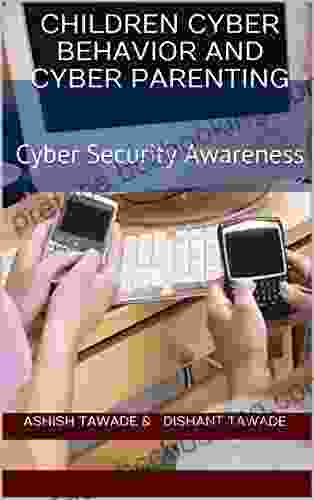Cyberbullying: A Growing Threat to Children

Cyberbullying is a type of bullying that uses electronic devices to bully or harass someone. It can take many forms, such as sending hurtful or threatening messages, posting embarrassing photos or videos, or spreading rumors online. Cyberbullying can have a devastating impact on children's mental health, causing anxiety, depression, and even suicidal thoughts.
4.4 out of 5
| Language | : | English |
| File size | : | 4822 KB |
| Screen Reader | : | Supported |
| Print length | : | 85 pages |
| Lending | : | Enabled |
The internet has made it easier for bullies to reach their victims. They can use social media, email, text messages, and other online platforms to bully someone anonymously. This can make it difficult for victims to escape the bullying, and it can also make it difficult for parents to monitor their children's online activity.
There are a number of things that parents can do to protect their children from cyberbullying. First, it's important to talk to your child about cyberbullying and make sure they know what to do if they are being bullied. You should also encourage your child to be respectful of others online and to avoid engaging with bullies.
If your child is being cyberbullied, it's important to take action. You should talk to your child and offer support. You should also report the bullying to the website or platform where it is happening. You may also want to contact the police or school if the bullying is severe.
Cyberbullying is a serious problem, but it is one that can be overcome. By working together, parents and children can create a safer online environment for everyone.
What is Cyberbullying?
Cyberbullying is a type of bullying that uses electronic devices to bully or harass someone. It can take many forms, such as sending hurtful or threatening messages, posting embarrassing photos or videos, or spreading rumors online. Cyberbullying can have a devastating impact on children's mental health, causing anxiety, depression, and even suicidal thoughts.
What are the Signs of Cyberbullying?
There are a number of signs that may indicate that your child is being cyberbullied. These include:
- Avoiding using the computer or phone
- Seeming upset or withdrawn after using the computer or phone
- Receiving hurtful or threatening messages
- Being the target of embarrassing or humiliating posts
- Having their personal information shared without their consent
What to Do If Your Child is Being Cyberbullied
If you think your child is being cyberbullied, it's important to take action. Here are some steps you can take:
- Talk to your child and offer support.
- Report the bullying to the website or platform where it is happening.
- Contact the police or school if the bullying is severe.
- Encourage your child to be respectful of others online.
- Educate your child about the dangers of cyberbullying.
How to Prevent Cyberbullying
There are a number of things that parents can do to help prevent cyberbullying. These include:
- Talk to your child about cyberbullying and make sure they know what to do if they are being bullied.
- Encourage your child to be respectful of others online.
- Monitor your child's online activity.
- Set limits on your child's screen time.
- Educate yourself about cyberbullying and how to prevent it.
Resources for Parents and Children
There are a number of resources available to help parents and children deal with cyberbullying. These include:
- The National Cyberbullying Helpline: 1-800-855-1885
- The National Suicide Prevention Lifeline: 1-800-273-8255
- The Cyberbullying Research Center: https://cyberbullying.org/
- The National Parent Teacher Association: https://www.pta.org/
Additional Information
For more information on cyberbullying, please visit the following websites:
- The National Cyberbullying Helpline: https://cyberbullyinghelpline.org/
- The National Suicide Prevention Lifeline: https://suicidepreventionlifeline.org/
- The Cyberbullying Research Center: https://cyberbullying.org/
- The National Parent Teacher Association: https://www.pta.org/
4.4 out of 5
| Language | : | English |
| File size | : | 4822 KB |
| Screen Reader | : | Supported |
| Print length | : | 85 pages |
| Lending | : | Enabled |
Do you want to contribute by writing guest posts on this blog?
Please contact us and send us a resume of previous articles that you have written.
 Book
Book Novel
Novel Page
Page Chapter
Chapter Text
Text Story
Story Genre
Genre Reader
Reader Library
Library Paperback
Paperback E-book
E-book Magazine
Magazine Newspaper
Newspaper Paragraph
Paragraph Sentence
Sentence Bookmark
Bookmark Shelf
Shelf Glossary
Glossary Bibliography
Bibliography Foreword
Foreword Preface
Preface Synopsis
Synopsis Annotation
Annotation Footnote
Footnote Manuscript
Manuscript Scroll
Scroll Codex
Codex Tome
Tome Bestseller
Bestseller Classics
Classics Library card
Library card Narrative
Narrative Biography
Biography Autobiography
Autobiography Memoir
Memoir Reference
Reference Encyclopedia
Encyclopedia Julia Lyon
Julia Lyon Gina Yashere
Gina Yashere Halina Ogonowska Coates
Halina Ogonowska Coates Hanna Reitsch
Hanna Reitsch Gordon S Barker
Gordon S Barker Sarah Vogel
Sarah Vogel Graham Hancock
Graham Hancock J D Ware
J D Ware Richard A Gabriel
Richard A Gabriel Margaret Rogerson
Margaret Rogerson Hannah Ewens
Hannah Ewens Nancy Furstinger
Nancy Furstinger Hanalei Souza
Hanalei Souza Gwendoline Smith
Gwendoline Smith Greg Vinall
Greg Vinall Gordon Ramsay
Gordon Ramsay Greg Witt
Greg Witt Tessa Bailey
Tessa Bailey Gregory Orfalea
Gregory Orfalea Kent Lineback
Kent Lineback
Light bulbAdvertise smarter! Our strategic ad space ensures maximum exposure. Reserve your spot today!

 Robert Louis StevensonAmazing Adventures: A Naturalist Conservationist and Explorer's Journey
Robert Louis StevensonAmazing Adventures: A Naturalist Conservationist and Explorer's Journey Stuart BlairFollow ·16.7k
Stuart BlairFollow ·16.7k Chase MorrisFollow ·7k
Chase MorrisFollow ·7k Amir SimmonsFollow ·18.4k
Amir SimmonsFollow ·18.4k Hugo CoxFollow ·2.6k
Hugo CoxFollow ·2.6k Kenzaburō ŌeFollow ·14.5k
Kenzaburō ŌeFollow ·14.5k Gil TurnerFollow ·19.8k
Gil TurnerFollow ·19.8k Francis TurnerFollow ·11.6k
Francis TurnerFollow ·11.6k Jesus MitchellFollow ·16.8k
Jesus MitchellFollow ·16.8k

 Brady Mitchell
Brady MitchellMaster IELTS Speaking: The Ultimate Guide to Success
Kickstart Your IELTS...

 Branden Simmons
Branden SimmonsBack Spin: A Thrilling Myron Bolitar Novel
Get ready to embark on a...

 Marc Foster
Marc FosterData Structures and Algorithms: A Comprehensive Guide to...
In the ever-evolving...

 Jeff Foster
Jeff FosterUnveiling the Basics of Microbiology: A Comprehensive...
The world of...

 J.D. Salinger
J.D. SalingerHold Tight Suspense Thriller: A Gripping Page-Turner That...
Are you ready for a suspense thriller that...
4.4 out of 5
| Language | : | English |
| File size | : | 4822 KB |
| Screen Reader | : | Supported |
| Print length | : | 85 pages |
| Lending | : | Enabled |












